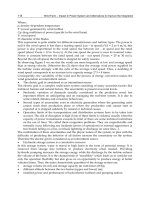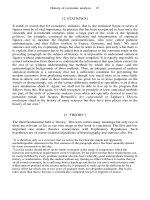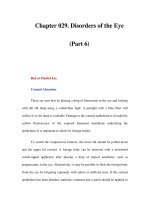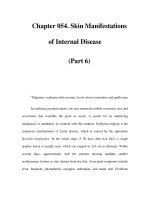Examination of the Newborn - part 6 doc
Bạn đang xem bản rút gọn của tài liệu. Xem và tải ngay bản đầy đủ của tài liệu tại đây (409.97 KB, 23 trang )
ABNORMAL FINDINGS AND CONGENITAL ABNORMALITIES 99
100 EXAMINATION OF THE NEWBORN
ABNORMAL FINDINGS AND CONGENITAL ABNORMALITIES 101
102 EXAMINATION OF THE NEWBORN
ABNORMAL FINDINGS AND CONGENITAL ABNORMALITIES 103
104 EXAMINATION OF THE NEWBORN
occurs when the level of circulating bilirubin becomes elevated.
This commonly occurs in the newborn baby about 3 days after
delivery as a result of increased red cell breakdown and
immaturity of the liver. Jaundice occurring earlier than this, and
especially within 24 hours of delivery, usually requires
investigation, as does jaundice occurring after 10 days of age. It is
also worthwhile considering the possibility of abnormal causes of
jaundice in a baby who develops it within the period 3–10 days of
age. For causes see Table 6.1.
Behaviour
Abnormal cry
In order to appreciate an abnormal cry the practitioner has to be
familiar with what a normal cry sounds like. The best way to do this
is to spend time on a postnatal ward listening to the crying of
babies. An example of an abnormal cry is a high-pitched cry. For
causes see Table 6.1.
Abnormal posture
When a baby is first delivered it usually adopts the posture it had
in utero, e.g. an extended breech baby will attempt to lie with its
hips flexed and its feet almost up by its ears. Gradually the baby
adopts a flexed posture with elbows, knees and hips flexed. For
causes of abnormal posture see Table 6.1.
Irritability
Most babies cry at some time, but they are generally consolable
either by picking them up and comforting them, changing their
nappy or by feeding them. A baby who cannot be consoled may
have an underlying reason for this (see Table 6.1).
Sleepy
Most babies sleep for most of the day, but they do tend to wake for
feeds. Excessive sleepiness is abnormal. For causes see Table 6.1.
ABNORMAL FINDINGS AND CONGENITAL ABNORMALITIES 105
JAUNDICE
This is a yellow discoloration of the skin and sclera of the eyes. It
TABLE 6.2 Observed conditions with suggested investigations in management
106 EXAMINATION OF THE NEWBORN
ABNORMAL FINDINGS AND CONGENITAL ABNORMALITIES 107
108 EXAMINATION OF THE NEWBORN
ABNORMAL FINDINGS AND CONGENITAL ABNORMALITIES 109
110 EXAMINATION OF THE NEWBORN
Inability to feed or suck
This may alert the practitioner to examine for prematurity (assess
gestational age) and exclude physical anomalies such as cleft
palate. Jaundice may also render the baby reluctant to feed, or
there may be a neurodevelopmental abnormality requiring further
investigation (Table 6.1).
Vomiting
Most babies will vomit at some time. Frequent large vomits are
abnormal and a cause should be sought (Table 6.1).
Bile-stained vomit (green or yellow) is abnormal and is likely to
indicate an intestinal obstruction.
Blood-stained vomit may be the result of ingestion of maternal
blood, trauma or a coagulation problem (excluded by checking the
clotting and the platelet count).
Abnormal movement
Asymmetry
Babies should be capable of moving both sides of their body to the
same degree—not necessarily at the same time! If movement
appears to be asymmetrical there may be an underlying cause (see
Table 6.1).
Fits
At some point in time most babies will exhibit jerking movements.
Determining which of these movements are normal and which are
abnormal can be difficult. Jerking movements of the limbs that
settle when the limb is held are usually not significant, but those
that do not settle may well represent a fit. Other movements that
may represent a fit include ‘cycling’ movements of the arms and
legs. Sometimes the only evidence of a fit is a dusky (slightly
cyanosed) baby, resulting from a brief cessation of breathing (an
apnoea attack) caused by the fit. For causes of fits see Table 6.1.
Treat the fits if they are prolonged or are causing neonatal
compromise (apnoea, cyanosis and distress).
ABNORMAL FINDINGS AND CONGENITAL ABNORMALITIES 111
Jittery
A‘jitter’ is a rhythmical movement of the arms and legs that settles
when the limbs are steadied. It can be a normal finding (an
exaggerated normal response), but it may have an underlying
cause (see Table 6.1).
Scalp
Bruises/swelling
Bruising and swelling are common responses to trauma. Both will
resolve with time. Bruising may contribute to the development of
jaundice.
Caput succedaneum (Figure 6.1)
This is subcutaneous oedema resulting from prolonged labour. It
may present with or without bruising, and crosses suture lines.
This is a benign finding that will resolve fairly quickly.
Cephalhaematoma (Figure 6.2)
Trauma causes subperiosteal haemorrhage confined to the skull
bone(s). Swelling is contained within the suture lines but may be
unilateral or bilateral. This is a benign finding that will gradually
resolve and may contribute to the development of jaundice. The
swelling should not increase in size after the delivery.
Subaponeurotic haemorrhage (Figure 6.3)
Trauma to the scalp causes a subaponeurotic haemorrhage not
confined to a bone. The haemorrhage may be sufficient to
necessitate resuscitation with intravenous fluids. Haemoglobin
estimation may give some estimate of volume of blood loss,
although the result may be misleading. Transfusion is likely to be
necessary. A clotting screen may be abnormal owing to the
consumption of clotting factors, and treatment with
cryoprecipitate, platelets and vitamin K may be necessary.
Meningoceles and encephaloceles
These are usually found at the occiput in the midline. They are
usually associated with a bony defect of the cranium. A
112 EXAMINATION OF THE NEWBORN
meningocele contains meninges, i.e. the layers covering the spinal
column, but does not contain any neural tissue. An encephalocele
contains meninges and neural tissue. They may also be associated
with an abnormal neurological examination. A cranial ultrasound
will confirm the diagnosis, although a skull radiograph and cranial
computerised tomography (CT) scan may also be required.
Discussion and/or referral to a neurosurgeon will be necessary.
FIGURE 6.1 Caput succedaneum
FIGURE 6.2 Cephalhaematoma
ABNORMAL FINDINGS AND CONGENITAL ABNORMALITIES 113
Face
Asymmetry
May be the result of the baby lying awkwardly in utero, but it can
occur with syndromes such as Goldenhar’s syndrome (see p. 163),
and it can occur in association with hemihypertrophy (enlargement
of one side of the body). Hemihypertrophy may also be associated
with nephroblastoma (a renal tumour).
In the case of a postural deformity, the only action necessary is
to explain to the parents that this is usually a benign finding that
will resolve fairly quickly. If there is associated hemihypertrophy a
renal ultrasound scan should be arranged. It may be necessary to
enlist the services of a geneticist to identify a syndrome if one is
suspected. Severe facial abnormalities may benefit from referral to
a craniofacial surgical team.
Small jaw
May be familial or it may occur as part of a syndrome, e.g. Pierre-
Robin (see p. 160) syndrome. The first thing to do is to take a
close look at the parents. If you suspect Pierre-Robin syndrome is
likely, be sure to look for an associated cleft palate.
FIGURE 6.3 Subaponeurotic haemorrhage
114 EXAMINATION OF THE NEWBORN
Dysmorphic facies
These may be familial, so always look at the parents. They can
also occur in certain syndromes, e.g. Goldenhar’s, Down’s,
Turner’s (see p. 163), and in association with metabolic conditions,
e.g. mucopoly-saccharidoses and congenital hypothyroidism.
If you suspect a syndrome look for other features associated
with the syndrome. Chromosome analysis may assist in
confirmation or identification of a syndrome. It may be necessary
to enlist the services of a geneticist to identify a syndrome if one is
suspected.
Birthmarks (see Skin, p. 126)
There are many types of birthmarks, but those occurring most
commonly in the neonatal period include the following:
Salmon patch naevus
Salmon patch naevus does not require intervention.
Port wine stain
Port wine stain in the distribution of the first branch of the
trigeminal (third cranial) nerve may be associated with vascular
malformation of the meninges and cerebral cortex on the same
side. Radiological investigation, e.g. cerebral ultrasound, CT scan
or magnetic resonance imaging (MRI), will help to exclude such
involvement and should be considered. Referral to a dermatologist
for cosmetic treatment should also be considered.
Strawberry haemangioma
This may need to be referred to a dermatologist if it involves the
eyelid or has the potential to obstruct vision in the early years.
Otherwise, after its rapid growth spurt, it should resolve.
Cavernous haemangioma
This should be referred to a dermatologist.
ABNORMAL FINDINGS AND CONGENITAL ABNORMALITIES 115
Nose
Obstruction
Failure of the nasal passages to become patent may cause
obstruction (unilateral or bilateral choanal atresia) as may
deviation of the nasal septum.
BILATERAL CHOANAL ATRESIA
Bilateral choanal atresia requires urgent treatment, which
consists of establishing a patent airway and urgent referral to an
ENT surgeon.
UNILATERAL CHOANAL ATRESIA
Unilateral choanal atresia requires referral to an ENT surgeon,
but the urgency is not quite so great as with a bilateral atresia. A
deviated nasal septum may require referral to an ENT surgeon.
Mouth
Neonatal teeth
Teeth present at or shortly after delivery are not common but
should be referred to the orthodontic team, for they may be quite
loose and can be inhaled if not removed electively.
Cleft lip
This condition is sometimes detected in the antenatal period,
especially in maternity units where detailed anomaly ultrasound
scans are routine. In such cases the baby would be automatically
referred to and examined by a paediatrician. However, it is worth
noting that women who have had scans during which the
condition was not detected may feel confused and betrayed and
will require a lot of support. Practitioners should be familiar with
local policies and resources regarding
1 the timing of surgical closure of the cleft;
2 equipment to help with feeding difficulties;
3 photographs showing babies before and after surgical
repair; and
116 EXAMINATION OF THE NEWBORN
4 local and national support groups (see Appendix 1).
Cleft lip can be familial, but it may occur as a result of
chromosomal abnormalities, e.g. Patau’s syndrome (see p. 161), or
antenatal maternal medication, e.g. phenytoin.
Look carefully for an associated cleft palate and for other
features that might suggest a syndrome. Early referral to a plastic
surgeon is required in order that the optimal time for treatment
can be discussed.
Cleft palate
Fifty per cent of cases involve both lip and palate. Cleft palate is
associated with the same aetiology as cleft lip described above.
Urgent referral to the ‘cleft lip team’ (plastic surgeon, ENT surgeon,
audiologist, orthodontic surgeon, and speech therapist) should be
made.
Cysts
Ranulae
Are mucus retention cysts and appear as blue lumps beneath the
anterior part of the tongue. They may be large enough to displace
the tongue posteriorly and interfere with respirations. In the event
of this happening, they can be aspirated, but they are usually left
alone if they do not interfere with feeding or breathing.
Ebstein’s pearl
See Milia (p. 127).
Tongue
Cysts and dimples
During development the thyroid develops from an area along the
tongue and migrates down the thyroglossal tract in the neck to its
final position. Remnants of the thyroglossal tract can present as
cysts and dimples. If a cyst is sufficiently large to cause problems
with feeding or respiration, consideration should be made whether
or not the cyst contains thyroid tissue before it is removed.
ABNORMAL FINDINGS AND CONGENITAL ABNORMALITIES 117
Tongue-tie
Is a term used to describe a condition in which the frenulum of
the tongue is attached too far forward. It does not usually interfere
with either speech or feeding and intervention is not usually
recommended, as division of the frenulum is often associated with
considerable haemorrhage.
Ears
Absence
This is a rare finding, and any baby with this defect should be
referred to the ENT surgeon, plastic surgeon and the audiologist.
Abnormal shape
Dysmorphic ears can occur as a result of a syndrome, e.g.
Treacher-Collins (see p. 159), may be developmental or may be
familial. Any baby with such an abnormality should be referred to
the ENT surgeon, plastic surgeon and the audiologist.
Position
Low-set ears may be indicative of a syndrome, e.g. Edward’s
syndrome.
Pre-auricular skin tags
Pre-auricular skin tags are not uncommon and are not always
associated with abnormal hearing. If there are multiple skin tags,
it is usually worthwhile requesting an audiology screen. All pre-
auricular skin tags are best referred to the plastic surgeons for
removal.
Pre-auricular dimples
Pre-auricular dimples are more likely to be associated with
abnormalities of hearing, and any baby with this defect should be
referred to the plastic surgeon and the audiologist.
118 EXAMINATION OF THE NEWBORN
Eyes
Discharge
Causes include infection (conjunctivitis) and blockage of the
lachrymal duct. Despite the common nature of this symptom in
neonates, it should be carefully monitored and appropriately
investigated. If an infection is suspected because the discharge is
profuse or purulent, the eye should be swabbed for bacterial and
chlamydial infection and the baby should be started on topical
antibiotics. Ointments are more effective in the treatment of eye
infections as they remain in contact with the eye for a greater
period of time. Infection can be gonococcal, staphylococcal or
chlamydial.
Gonococcal infection usually manifests 2–5 days after delivery;
the discharge is copious and purulent and occurs in association
with oedema of the eyelids and conjunctiva. Intensive treatment of
both eyes is necessary as the condition may lead to ulceration and
perforation of the eye.
Staphylococcal conjunctivitis manifests 3–5 days after delivery
and is less severe than gonococcal infection.
Chlamydial conjunctivitis usually occurs later than gonococcal
and staphylococcal conjunctivitis. Isolation of the organism
requires a conjunctival scrape sample to be analysed for
intracellular inclusions. It will respond to erythromycin, but
untreated it can cause damage to the eye. A blocked lachrymal
duct usually becomes patent with time and rarely requires
ophthalmic intervention to unblock it.
Confirmation of gonococcal or chlamydial infection in the
neonate should be followed by counselling for the mother and her
partner.
Ptosis
This is the term used to describe a drooping eyelid. It may be
congenital. If the drooping lid covers the pupil, referral to an
ophthalmologist is necessary in order that vision can be
accurately assessed.
Squint
This is common in babies, but it is usually a transient finding
which corrects itself within minutes. Epicanthic folds (see p. 72)
and a broad nasal bridge can often produce an apparent squint.
ABNORMAL FINDINGS AND CONGENITAL ABNORMALITIES 119
Few genuine squints are detected in the neonatal period, but if the
practitioner is convinced that there is a persistent squint the baby
is best referred to an ophthalmologist for an opinion.
Epicanthic folds
These are vertical pleats of skin that overlap the medial angle of
the eye (see Figure 5.2). They are common in infants and may
result in the illusion that there is a squint. They are a normal
feature in the Mongoloid races and in Down’s syndrome (see p.
157).
Anophthalmia
Absence of an eye can occur spontaneously or as part of a
syndrome. It is usually associated with a shallow orbit, so for
cosmetic reasons, and for examination of the normal eye, the baby
should be referred to an ophthalmologist.
Microphthalmia
A small eye may occur as a result of congenital infection, e.g.
rubella. It will almost certainly interfere with vision, so the baby
should be referred to an ophthalmologist. It may be worth
screening for evidence of congenital infection, and other features
suggestive of congenital infection should be sought.
Macrophthalmia
A large eye most commonly occurs as a result of congenital
glaucoma, a condition in which the drainage of fluid from the eye
is obstructed so causing a build-up of pressure in the eye. The
cornea may also appear hazy in association with congenital
glaucoma. Referral to an ophthalmologist should be made as a
matter of urgency.
Coloboma
Coloboma of the iris appears as a sector-shaped gap. That gap
may extend posteriorly to include the ciliary body and choroid. It
may be isolated or part of a syndrome. Referral to an
ophthalmologist is necessary.
120 EXAMINATION OF THE NEWBORN
Aniridia
Absence of the iris can occur spontaneously or in association with
nephroblastoma. Referral to an ophthalmologist is necessary and
the kidneys should be scanned.
Heterochromia
An iris that has different pigment may not be apparent at birth
but may develop as the eyes change from their newborn blue to
their ‘adult’ colour.
Translucent iris
This occurs when there is reduced pigmentation of the iris, as
occurs in albinism. Referral to an ophthalmologist is necessary.
White reflex (see Red reflex, p. 72)
A white, rather than red reflex occurs with retinoblastoma (a
retinal tumour) or scarring of the retina. The baby should be
referred to an ophthalmologist for an opinion.
Cataract
A cataract is an opacity of the lens. Cataracts vary in size and may
be small dot-like lesions that cause no interference with vision, or
they may be severe enough to produce a completely opaque lens.
Some are hereditary; others are attributable to congenital
infection, e.g. rubella, or biochemical imbalance, e.g.
hypocalcaemia. The baby should be referred to an
ophthalmologist to assess vision.
Neck
The neck may be shortened in association with vertebral
anomalies, e.g. Klippel-Feil syndrome. Turner’s syndrome is
associated with webbing of the neck. Damage to the sternomastoid
muscle results in a sternomastoid tumour, a benign swelling
within the muscle, and congenital torticollis (‘wry neck’).
Abnormal swelling of the neck may result from a sternomastoid
tumour or a cystic hygroma (a multicystic lesion of lymphatic
origin). Branchial cleft remnants may present as dimples.
ABNORMAL FINDINGS AND CONGENITAL ABNORMALITIES 121









